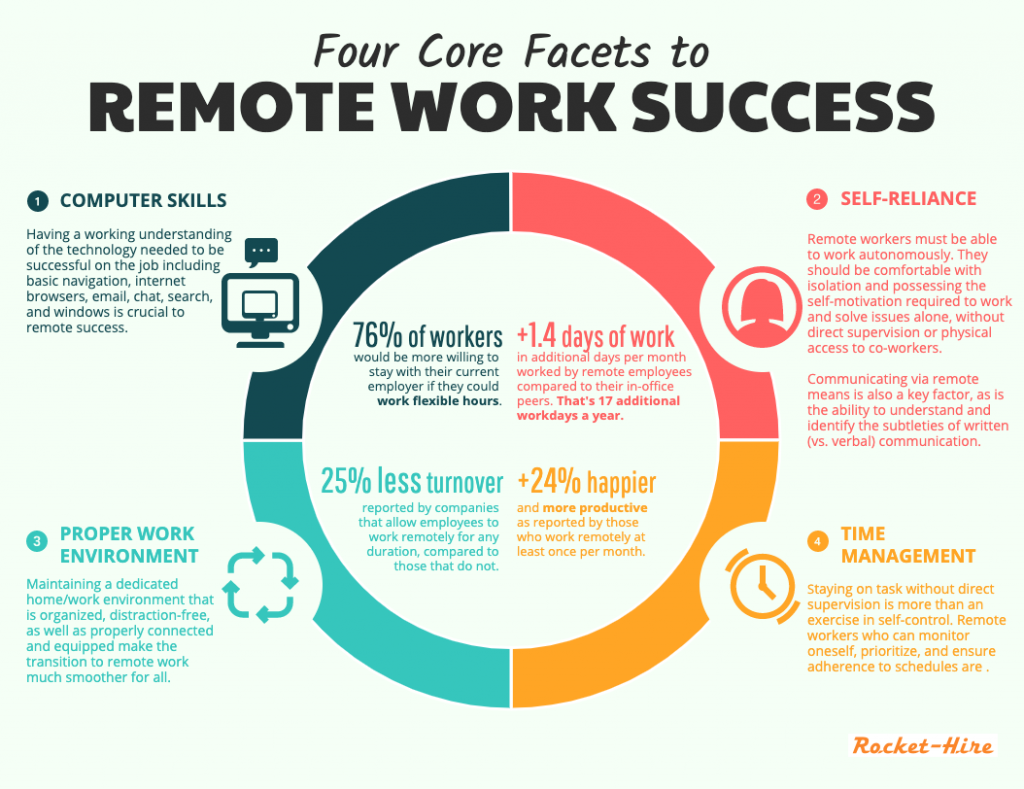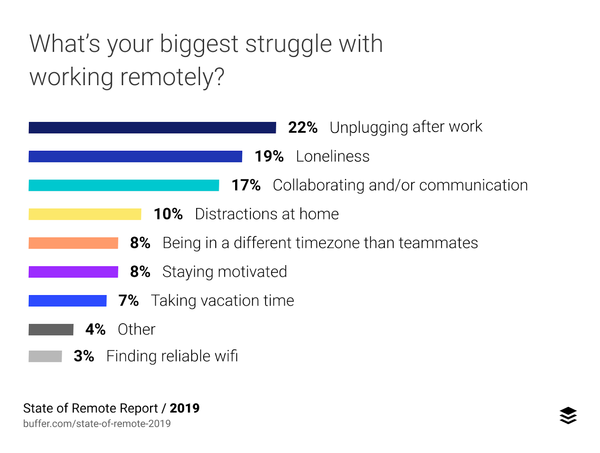Are you ready?
Once the pandemic has subsided (soon please!) the learnings from the adaptations we have been forced to make will undoubtedly drive long-lasting changes. It seems inevitable that one such change will be an accelerated shift to remote work. Even before Novel Corona, new technology and a demand for flexibility have pushed a steady increase in home-based, and “Work From Anywhere” workers.
According to Global Workplace Analytics,
- Regular work-at-home has grown 173% since 2005
- Which equates to 11% faster than the rest of the workforce (which grew 15%)
- And nearly 47x faster than the self-employed population (which grew by 4%)
- 56% of employees have a job where at least some of what they do could be done remotely
- Only 3.6% of the workforce (about 5 million people) currently work-at-home half-time or more
These statistics show that we have not even scratched the surface when it comes to the size of the remote workforce. It is likely that the current forced march up the home-based work adoption curve will see a shift from our current “early adoption” phase to work from anywhere becoming mainstream. Under the present circumstances necessity is giving many workers and employers alike their first taste of remote work, and like it or not, for many there will be no turning back.
Is remote work really a good thing?
Historically there is compelling evidence for the positive impact of home-based work for both employers and employees.
There is some evidence of increased productivity. According to The Ultimate List of Remote Worker Statistics 2020 Edition by Small Business Genius:
- Companies allowing remote work have 25% lower employee turnover than those that don’t.
- 76% of workers would be more willing to stay with their current employer if they could work flexible hours.
- People who work remotely at least once a month are 24% more likely to be happy and productive.
- Remote employees work an additional 1.4 more days per month than in-office employees, which is nearly 17 additional workdays a year.
- 37% of remote employees would take a 10% pay cut to continue working from home.
Work from anywhere provides employers access to geographically inflexible employees that they otherwise would not be able to hire. Having the freedom to put the right person in the right job – with no geographic boundaries – work from anywhere can be a win-win because it removes major roadblocks on the road to global happiness and productivity.
But success with work from anywhere is not automatic
The question isn’t if remote work is going to become more common, or lead to increased productivity, but rather “Are workers and their employers cut out to handle remote work?” Gauging readiness for remote work boils down to a few key criteria:
First and foremost
The work itself has to be able to be performed remotely. So far it is simply not possible to serve a hot latte over the internet. According to the U.S. Bureau of Labor Statistics, only 29 percent of Americans can work from home, including one in 20 service workers and more than half of information workers. While 70% of the workforce may not be able to work remotely, the remaining 30% represents millions and millions of individuals, and this number is sure to increase as manufacturing and service jobs become automated.
Assuming the job can be done remotely, the employer has to have the right infrastructure in place. Tech that goes beyond simple access to the internet is going to become essential. VPNs are essential and the simple issue of lack of bandwidth on those networks can lead to significant limitations.
While the desire and expectation of working remotely increase significantly every year amongst the workforce, companies are only slowly adopting remote-friendly policies.
To drive the full engagement of a remote workforce, employers also have to pony up and show remote workers the love by handling the additional costs that come with remote work. According to a survey by Buffer on remote work, 75% of remote workers said their companies don’t cover internet costs, and 71% said their employers don’t pay for coworking spaces for their employees. Forming motivating psychological connections with employees will require making sure they feel the arraignment is equitable.
Employers and workers alike need to realize that remote work is not for everyone
Just like with any job or situation- some people are going to be better equipped to succeed than others. As this shift occurs and the inevitable spike in work from home occurs, it will become even more important to understand what characteristics are required for success in work at home roles.

The contact center industry has been a leader in the shift to home-based work. With a good internet connection and computer hardware, contact center work can easily be done from home. When one of Rocket-Hire’s clients decided to begin shifting their agents to home-based work, they asked us to build a pre-hire assessment to gauge an applicant’s suitability for home-based work. The first step in our process was to use surveys and interviews to study the characteristics required for success as a home agent. We then developed a profile for success that included facets relating to each of the following 4 core areas:
- Self-Reliance/Autonomy
Must be able to work autonomously and comfortable working in isolation, possessing the self-motivation required to work and solve issues alone, without direct supervision or physical access to co-workers. Must be able to communicate effectively via remote means, understanding the subtleties of written (vs. verbal) communication.
- Time management
Must be able to stay on task and manage time efficiently without direct supervision by showing the self-control needed to monitor oneself, prioritize, and ensure adherence to schedule.
- Proper work environment
Is able to maintain a dedicated home/work environment that is organized, distraction-free, and is properly connected and equipped.
- Computer skills
Has a working understanding of the technology needed to be successful on the job, including basic navigation, internet browsers, email, chat, search, and windows.
While this model was created with a focus on call center jobs, much of it applies to almost any remote work. The graph below (taken from Buffer.com’s annual survey of 2,500 remote workers) which summarizes the most difficult aspects of working remotely reinforces our findings.
While Buffer’s survey is more focused on white-collar workers than ours, the ability to handle loneliness and the challenges of remote communication are consistent with our findings as two of the biggest barriers with remote work.
The psychology of one’s fit for a job is all about individual differences. Which differences are most critical for success depends heavily on the level of the job and the role itself. For instance, most white-collar professionals are going to have computer skills, connectivity, and the ability to manage their time; but virtually everyone working remotely will need to be able to have the ability and desire to work in isolation and manage the social issues that arise via the lack of ability to communicate face to face.
In an article that summarizes a research study Google conducted on its most productive groups, author Derek Thompson relates that “Google found that the most important quality was “psychological safety”—a confidence that team members wouldn’t embarrass or punish individuals for speaking up.”
Thompson further elaborates on this important finding –
“Beyond lost creativity and companionship, the gravest threat to many companies from remote work is that it breaks the social bonds that are necessary to productive teamwork. But online communications can be a minefield for psychological safety, according to Bill Duane, a former Google engineer who now works remotely as a corporate consultant and researcher. “Whenever we read a sentence on Gchat or Slack that seems ambiguous or sarcastic to us, we default to thinking, You fucker!” Duane told me. “But if someone had said the same thing to your face, you might be laughing with them….Office banter, bad jokes, and even unctuous corporate talk in the hallways can be dismissed as empty blather. But Duane calls these things “the carrier wave for psychological safety.” Almost everything that doesn’t feel like work at the office is what makes the most creative, most productive work at the office possible.
Individual differences such as ability to manage social distance and loneliness make some workers much better at handling remote work than others.
The right talent strategy
Success with remote work requires a talent strategy that is tuned into signals that indicate where individual job applicants and workers alike fall on critical factors needed for success. Assessment provides a reliable and accurate signal on individual differences required for success and is a critical ingredient in any talent strategy. Remote work is no exception to the assessment’s proven value proposition for both hiring and development and provides the information needed to determine if a worker has the right stuff to handle the psychological hardships of remote work.
Looking towards the future
An increase in remote workers is inevitable and navigating the pros and cons requires employers to keep their eyes on the macro-trends that will shape the future of remote work. Key trends include:
Remote meeting technologies
According to Thalia Wheatley, a professor of psychological and brain science at Dartmouth who studies the difference between face-to-face and online interaction (as quoted in Time Magazine):
“The thing that has to get solved on the tech side,” says Wheatley, “is the tech needs to kind of disappear so that you believe that you are in the room.”
Corona is already accelerating the use and development of remote conferences, and new tech such as holographic conference calls will continue to remove barriers.
The gig economy
The gig economy is real and it will continue to grow. It is likely that in 10-20 years companies will routinely assemble teams made up of independent remote workers who lend their expertise and skill on a project basis to multiple organizations. Remote work is essential for the gig economy.
Generational differences
Millennials, Generation Z, and Generation Alpha, are already used to interacting virtually. This trend will continue and such that the workforce of the future will no doubt have an easier time with remote collaboration. Employers should tune into what these generations are doing now in order to stay ahead of the trends and provide an easier on-ramp to employing the workforce of the future.
The writing is on the virtual conference room wall – remote work is coming and, like it or not, employers need to be prepared. Our current experience with Corona will accelerate the curve and if handled correctly will lead to increased productivity, profitability, and worker happiness.
